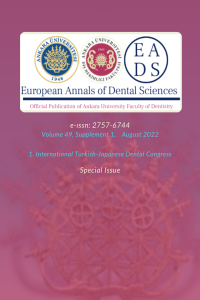Abstract
References
- Referans 1. Silverman E, Cohen M, Gianelly AA, Dietz VS: A universal direct bonding system for both metal and plastic brackets. Am J Orthod. 1972;62(3):236-244. doi:10.1016/s0002-9416(72)90264-3
- Referans 2. Thomas RG: Indirect bonding: simplicity in action. J Clin Orthod. 1979;13(2):93-106.
- Referans 3. Klocke A, Tadic D, Vaziri F, Kahl-Nieke B. Custom base preaging in indirect bonding. Angle Orthod. 2004;74(1):106-111. doi:10.1043/0003-3219(2004)074<0106:CBPIIB>2.0.CO;2
- Referans 4. Pamukçu H, Özsoy ÖP: Indirect Bonding Revisited. Turk J Orthod. 2016;29(3):80-86. doi:10.5152/TurkJOrthod.2016.16023
- Referans 5. Årtun, J. and S. Bergland: Clinical trials with crystal growth conditioning as an alternative to acid-etch enamel pretreatment. Am J Orthod 1984;85:333–340.
- Referans 6. Greenlaw R, Way DC, Galil KA: An in vitro evaluation of a visible light-cured resin as an alternative to conventional resin bonding systems. Am J Orthod Dentofacial Orthop. 1989;96(3):214-220. doi:10.1016/0889-5406(89)90458-7
- Referans 7. G. Bradburn, N. Pender: An in vitro study of the bond strength of two light-cured composites used in the direct bonding of orthodontic brackets to molars, Am J Orthod Dentofacial Orthop, 1992;102(5):418-426 ISSN 0889-5406, https://doi.org/10.1016/S0889-5406(05)81188-6.
IN VITRO COMPARISON OF INDIRECT BONDING METHODS USING DIFFERENT ISOLATION AND ADHESIVE SYSTEMS WITH EACH OTHER AND WITH THE DIRECT BONDING TECHNIQUE
Abstract
Aim: To compare the shear bond strength and adhesive remnant index of a new indirect bonding isolation method for different adhesive systems with the direct bonding technique.
Methods: 100 premolar and 10 centrally extracted human teeth were bonded with one direct and four indirect bonding methods, and then subjected to 1000 thermal cycles between 5°C and 55°C. ARI was analyzed by the chi-square test. The Shear Bond strength was analyzed by the analysis of variance (ANOVA) and the Tukey multiple comparison (HSD) test. The bracket-enamel interface area of two teeth from each group was examined under SEM.
Results: All groups provided clinically acceptable bond strengths. In the traditional isolation + light-cured bonding group with the highest bonding values identified, the scores for all failures were recorded as 3 and this group differs from all other groups in respect of ARI scores (p<0.05). In addition, it was identified from SEM images that there were air bubbles in the adhesive layer in the groups where chemical adhesives were used.
Conclusion. When tape is used as the isolation material, the laboratory process stage is shortened and simplified. Therefore, if the custom base indirect bonding technique is to be used, this new method can be used with light-cured bonding agent for isolation.
Keywords
References
- Referans 1. Silverman E, Cohen M, Gianelly AA, Dietz VS: A universal direct bonding system for both metal and plastic brackets. Am J Orthod. 1972;62(3):236-244. doi:10.1016/s0002-9416(72)90264-3
- Referans 2. Thomas RG: Indirect bonding: simplicity in action. J Clin Orthod. 1979;13(2):93-106.
- Referans 3. Klocke A, Tadic D, Vaziri F, Kahl-Nieke B. Custom base preaging in indirect bonding. Angle Orthod. 2004;74(1):106-111. doi:10.1043/0003-3219(2004)074<0106:CBPIIB>2.0.CO;2
- Referans 4. Pamukçu H, Özsoy ÖP: Indirect Bonding Revisited. Turk J Orthod. 2016;29(3):80-86. doi:10.5152/TurkJOrthod.2016.16023
- Referans 5. Årtun, J. and S. Bergland: Clinical trials with crystal growth conditioning as an alternative to acid-etch enamel pretreatment. Am J Orthod 1984;85:333–340.
- Referans 6. Greenlaw R, Way DC, Galil KA: An in vitro evaluation of a visible light-cured resin as an alternative to conventional resin bonding systems. Am J Orthod Dentofacial Orthop. 1989;96(3):214-220. doi:10.1016/0889-5406(89)90458-7
- Referans 7. G. Bradburn, N. Pender: An in vitro study of the bond strength of two light-cured composites used in the direct bonding of orthodontic brackets to molars, Am J Orthod Dentofacial Orthop, 1992;102(5):418-426 ISSN 0889-5406, https://doi.org/10.1016/S0889-5406(05)81188-6.
Details
| Primary Language | English |
|---|---|
| Subjects | Dentistry |
| Journal Section | Conference Papers |
| Authors | |
| Publication Date | August 31, 2022 |
| Submission Date | August 31, 2021 |
| Published in Issue | Year 2022 Volume: 49 Issue: Suppl 1 |


